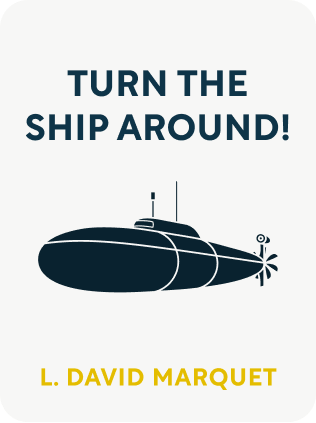

This article is an excerpt from the Shortform book guide to "Turn the Ship Around" by L. David Marquet. Shortform has the world's best summaries and analyses of books you should be reading.
Like this article? Sign up for a free trial here .
What is the leader-leader model? How is it different from the leader-follower model in its function and effectiveness?
The traditional leader-follower model practiced in most organizations assumes there are two types of people: leaders who make decisions and followers who implement them. The leader-leader model is based on a different assumption about people: everyone can be a leader, and an organization is most effective when everyone thinks and acts like a leader.
Read more to learn about the leader-follower model and the leader-leader model.
The Leader-Follower Model
The traditional leader-follower model practiced in the U.S. Navy and most organizations assumes there are two types of people: leaders who make decisions and followers who implement them.
The leader-follower model is revered because it has worked. It’s responsible for successes ranging from the construction of the pyramids in ancient Egypt to the factories of the Industrial Revolution.
However, the leader-follower structure is designed to coordinate physical labor for various purposes, whether building pyramids and roads, or mining coal. In contrast, many of today’s employees are knowledge workers who work independently to develop and apply information. The leader-follower model doesn’t manage cognitive work effectively.
People who are treated as followers become passive. With scant decision-making ability, they have little motivation to contribute their ingenuity and energy.
Another factor limiting the leader-follower structure is that the organization’s success depends solely on the leader’s ability. This results in an overemphasis on the leader’s personality and on short-term results. When such a leader leaves an organization or company, performance often plummets because followers are dependent on the leader and can’t carry on without him.
The Leader-Leader Model
The leader-leader structure is based on a different assumption about people: everyone can be a leader, and an organization is most effective when everyone thinks and acts like a leader.
The leader-leader model increases individual motivation and organizational success by treating employees as valued assets with unique talents. Also, the improvements that come with the leader-leader model are lasting because they’re not dependent on a single leader’s skill, personality, or decisions.
Trial and Error
Marquet started his naval career as a junior officer on USS Sunfish, an attack submarine where the captain practiced empowerment. One day while Marquet and his team were on “watch,” the captain overheard Marquet comment to his sonar chief that he wished they could practice by bouncing active signals off a passing merchant vessel (usually submarines remain in a passive listening mode). The captain suggested that Marquet simply announce, “Sir, I intend to activate sonar for training.” Marquet did, and the captain replied, “Very well.”
It was Marquet’s first experience initiating and directing an activity—and he and his team were energized and motivated. That feeling stuck with him, and he later incorporated it into his own leadership philosophy and practice.
In 1989-91, after further training, Marquet was assigned as an engineer on a ballistic-missile submarine, USS Will Rogers, which was run by a strict top-down commander. He tried to decentralize decision-making among his crew members, but it failed because it didn’t fit within the traditional structure.
Eight years later, Marquet took command of Santa Fe, a nuclear-powered attack submarine. The crew and atmosphere were as dispirited as they had been on Will Rogers. This time, however, he resolved to go all the way with a decentralized decision-making approach.
A Leadership Revolution
With little room for error, a nuclear submarine is an unlikely setting for trying out a new leadership model. But to turn around the beleaguered Santa Fe, Marquet felt he had no other option than to deploy the leader-leader model.
Santa Fe’s crew was the worst in the fleet at meeting Navy performance standards, and its morale was among the worst. But within a year, under Marquet’s leadership, the crew jumped from last place to first by multiple Navy performance measures, including combat effectiveness and retention of officers and sailors. Because Santa Fe’s transformation wasn’t driven by its leader’s personality—but by developing leadership at all levels—its crew maintained the same top performance 10 years later.
Marquet’s effort to transform the operation involved these phases:
- Letting go of old ideas to make way for new ones
- Decentralizing decision-making while remaining responsible and accountable as the commander.
- Increasing the crew’s technical competence and knowledge to enable good decisions.
- Increasing everyone’s clarity on Santa Fe’s mission and purpose so individual decisions aligned with organizational goals.
Marquet’s book offers many stories that illustrate how the leader-leader model worked for his crew.

———End of Preview———
Like what you just read? Read the rest of the world's best book summary and analysis of L. David Marquet's "Turn the Ship Around" at Shortform .
Here's what you'll find in our full Turn the Ship Around summary :
- How a captain turned the U.S. Navy’s worst-performing nuclear submarine crew into one of the best
- The principles for developing leaders at all levels to create a passionate, high-performing workforce
- Why the "leader-leader" model works better than the "leader-follower" model






